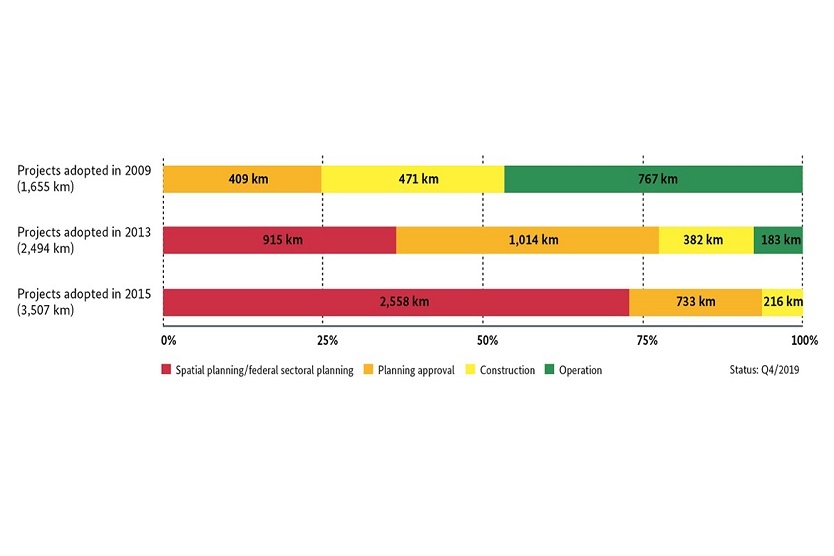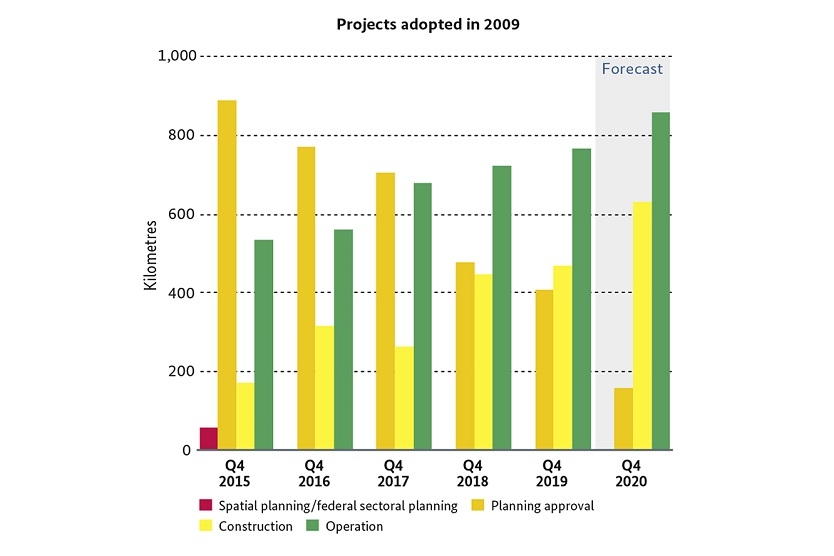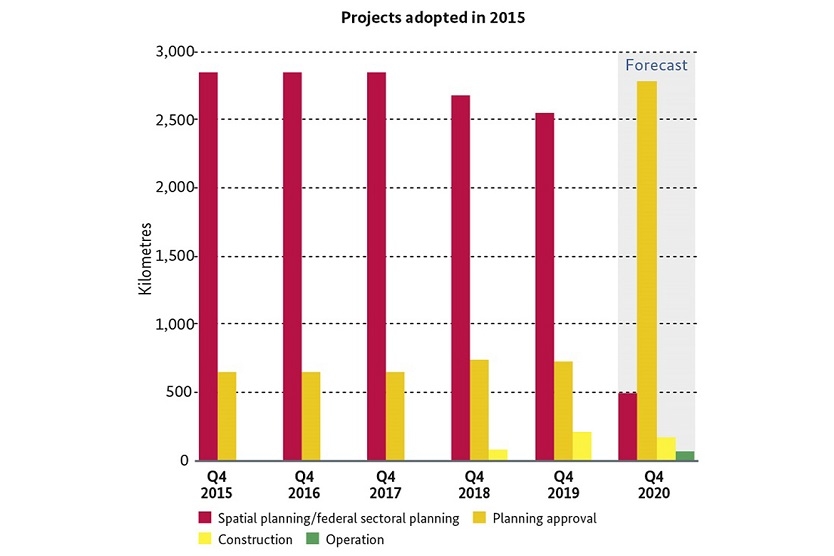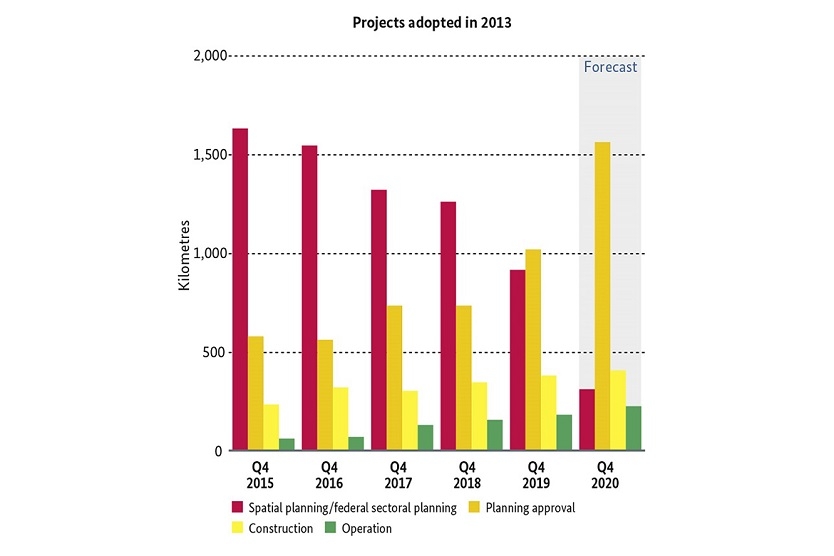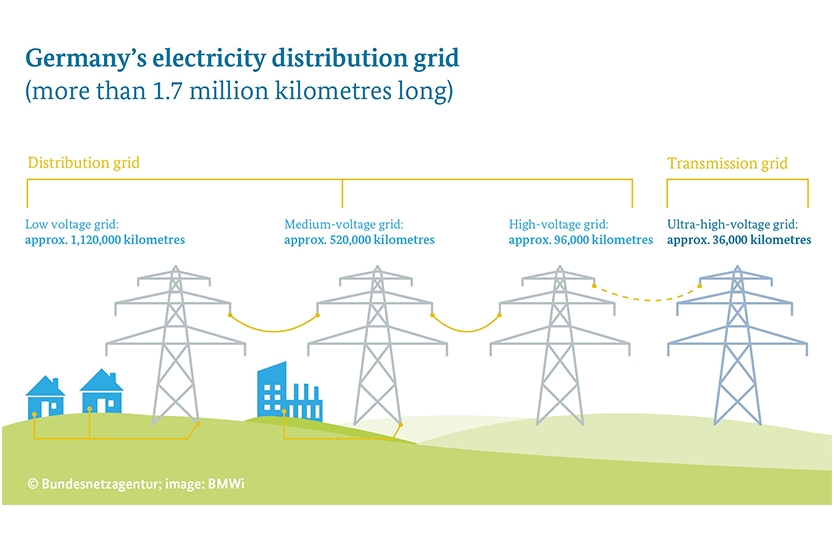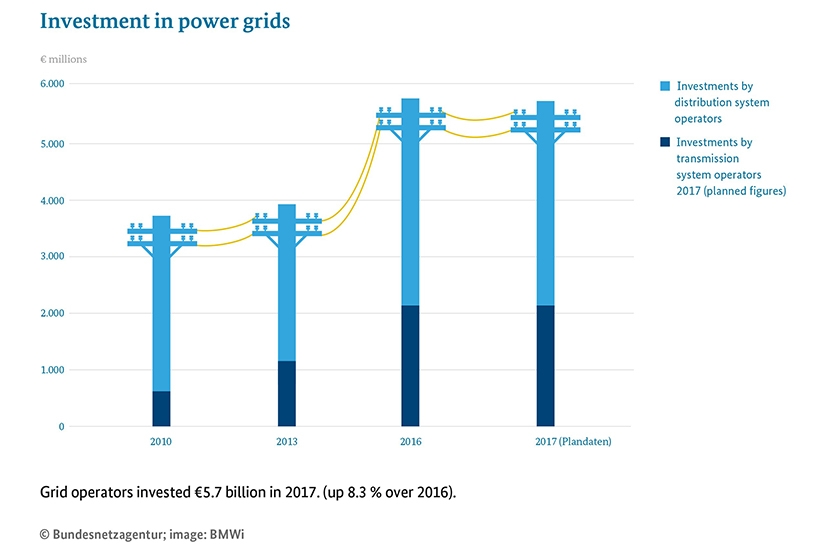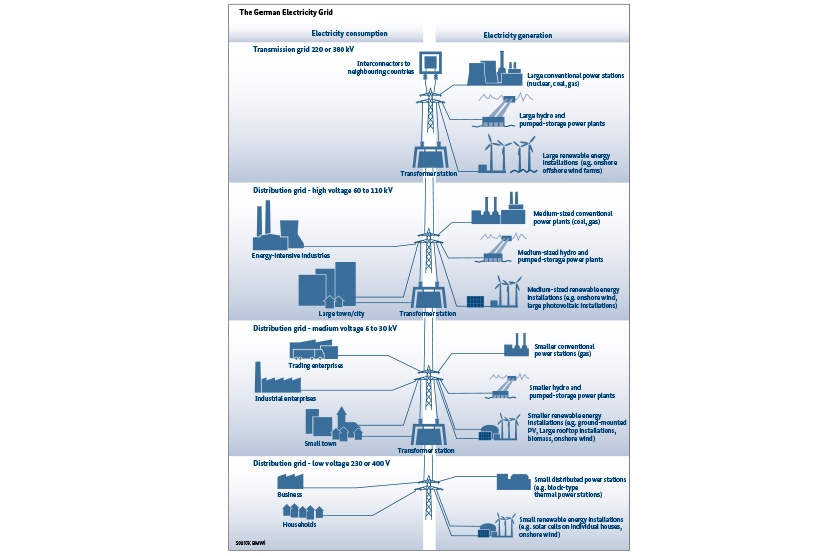The new generation situation with growing shares of electricity from renewable sources is creating fresh challenges for the grid: In some cases, electricity needs to travel long distances from the generators to the consumers.
For example, electricity from wind energy is mostly generated in the north and the east of Germany, as well as at sea; this is where the wind is particularly strong. But the main electricity consumers – particularly the large industrial operations – are to be found in the south and west of the country. So the wind power generated in the north needs to get to the south.
Making the grids fit for the energy transition
By the end of 2022, Germany’s nuclear power plants will have been gradually decommissioned, and other conventional power stations will also have closed down. These changes are affecting the grid: in total, more than 7,500 kilometres of transmission grid will need to be upgraded or newly constructed in the next few years. A major role here is played by the ultra-high-voltage direct-current transmission lines, the “electricity highways” like SuedLink and SuedOstLink. The upgrading of the interconnectors to our European neighbours is also becoming more and more important, because the task of realising the energy transition is increasingly being approached from a pan-European level. This allows us, for example, to combine hydroelectric power from Scandinavia and the Alpine countries with wind power and photovoltaics from Germany. And this cuts the costs of the energy transition.
It used to be the case that electricity travelled in one direction, from the power station via the transmission and distribution grids to the consumer, but today’s grids have to cope with “oncoming traffic”: electricity travels not only in the “top-down” direction, but also “bottom-up”. In order to coordinate generation and consumption in a demand-based and consumption-based manner, the electricity grid needs to become smarter.
Policy environment for the electricity grid of the future
The entire electricity grid, including all its various voltage levels, must be made fit for the energy transition. The Act to Change Provisions of Law on Energy Cable Construction, the Act on the Digitisation of the Energy Transition, and the revision of the Incentive Regulation Ordinance have put important policies in place to drive the expansion at transmission and distribution grid level, to make it citizen-friendly, and to make the grids fit to cope with their new tasks. You can find out more about the rules governing the grid expansion here (in German).
Electricity Grid Action Plan
In order to take action to speed up grid expansion, which had been slowing, in August 2018, the Federal Ministry for Economic Affairs and Climate Action presented the Electricity Grid Action Plan (in German) (PDF, 92 KB). This Plan follows a two-pronged approach: to optimise existing grids using new technologies and operating strategies, and to speed up grid expansion by simplifying planning procedures and utilising forward-looking controlling (in German) (PDF, 130 KB). The timetables for each grid expansion project are key elements of the controlling. Representatives from the Federal Ministry for Economic Affairs and Climate Action, the Bundesnetzagentur, and the Länder meet with grid operators on a regular basis to discuss each project. This enables every party involved to identify potential obstacles and risks for the timetables early on and to take measures to counter these. For more information on the controlling, please click here (in German) (PDF, 130 KB).
‘Electricity 2030’ discussion process
Germany has set itself ambitious targets: it wants to increase investments in efficiency technologies and to eliminate greenhouse gas emissions as much as possible by 2050. The time up to 2030 is crucial. The Federal Economic Affairs Ministry is therefore looking towards the future of ‘Electricity 2030’. Basing their work on recent studies, the energy transition platforms “Electricity Market” and “Energy Grids” discussed twelve long-term trends in the electricity sector. The trends show that wind and solar energy are having an increasing impact on the energy system, gradually becoming important energy sources while remaining secure and affordable. The outcome of the discussion process can be found in this paper.
2019-2030 Grid Development Plan
The 2019-2030 Grid Development Plan was endorsed by the Bundesnetzagentur in December 2019. The plan outlines the grid expansion and optimisation that is necessary up to 2030 to reach the climate targets in Germany. It does not describe any specific powerline routes, but only outlines the transmission requirements between specific grid connection points. It takes account of the coal phase-out in accordance with the results of the Commission for Growth, Structural Change and Employment, and, for the first time, also of the planning for the connection systems for offshore wind energy. Prior to this, there were public consultations on the drafts submitted by the transmission system operators, and the drafts were examined by the Bundesnetzagentur. For more information, please click here (in German).
Expansion of the electricity grid progressing well
In order to make sure our electricity supply remains secure and affordable, Germany needs several thousand kilometres of new power lines. This is a mammoth task that made significant progress in 2019 thanks to improved cooperation between all those involved and thanks to less bureaucracy.
At the end of 2019, around half of all projects under the Power Grid Expansion Act were in operation, another third is under construction. According to the agreed schedule, around 90 percent of these projects should be under construction or already in operation by the end of 2020. For the HDVC line SuedOstLink, the first of the major north-south power highways, the complete underground cable route corridor has now been determined. It is the first high voltage direct current transmission line. By the end of the year almost 90 percent of the projects should be in the planning approval phase according to the current Federal Requirements Plan Act or even further advanced. This means that grid expansion has advanced quite considerably in 2019.
This is particularly true in terms of the years of approval: Of the projects adopted in 2009, 767 kilometres (46 per cent) have entered into operation and a further 471 kilometres (28 per cent) are under construction. Of the projects adopted in 2013, 1,579 kilometres (63 per cent) were at the planning approval stage or further advanced in 2019. The figure for 2018 had been 49 per cent. Bureaucracy reduction resulting from the revision of the Act on Measures for Accelerating the Expansion of the Electricity Grid (NABEG 2.0) was also decisive for the 14 percent increase. The revised act has reduced unnecessary bureaucracy and streamlined procedures for grid expansion, especially when it comes to optimising and reinforcing existing lines. The act has directly helped with several grid expansion projects and shortened the official procedures by several years. Also, 949 kilometres (27 per cent) of the recent projects from 2015 have entered the planning approval procedure or are at a more advanced stage. The 2018 figure had been 821.
This grid expansion progress is summarised in a flyer (in German) (PDF, 4 MB). For further information regarding the current state of grid expansion projects, please visit www.netzausbau.de (in German).
